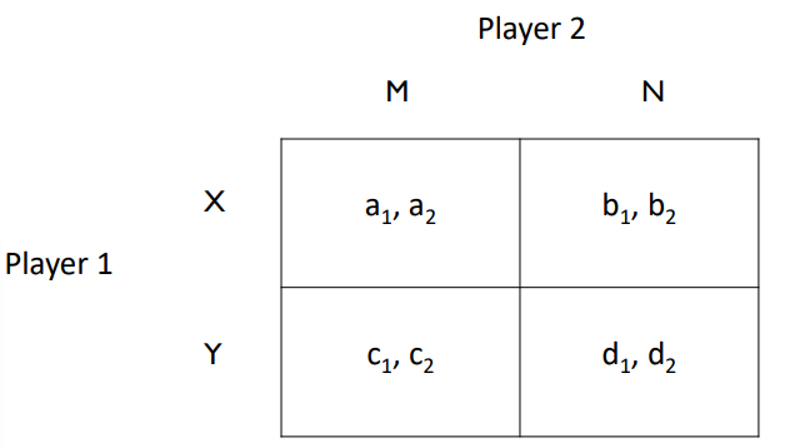Game Theory
1/19
There's no tags or description
Looks like no tags are added yet.
Name | Mastery | Learn | Test | Matching | Spaced |
|---|
No study sessions yet.
20 Terms
Non-Strategic Situations
Perfect competition – firms are price-takers, and they do not have to worry about the prices of their competitors
Monopoly – no competitors to worry about
Strategic Situations
Everything in between a Monopoly and Perfect Competition
Game Theory
Mathematical models to study strategic interactions
An interaction can be ‘cooperative’ or ‘competitive’
It is a tool-kit to study conflict and cooperation between intelligent and rational decision makers
Cooperative Interaction
e.g. when business partners collaborate on a project
Competitive/Conflicting Interaction
e.g. two or more firms fighting for market share, rival politicians in an election etc
Two Basic Models of Games
Simultaneously played games (Normal form/Strategic form)
Sequentially played games (Extensive form)
Simultaneously Played Games (Normal form/Strategic form)
where the players have to choose their decisions or actions simultaneously
doesn’t quite literally mean choosing at the same time; but means that the players choose a decision without knowing what others are doing
Sequentially Played Games (Extensive form)
Moves are made sequentially, one after the other
Players can see clearly what move have been taken so far before they make their own choice
Normal Form Game
Three elements:
Players
Strategies
Payoffs/Utilities

How to Solve a Game
There are many ways, and different economists have many slightly different ways of reaching the same result
One of the main methods used to then solve such a game is finding best responses and using this to identify a Nash equilibrium
Solution Qualities
The outcome is stable: This means nobody has an incentive to move from an outcome
The outcome is reached by rational thinking: This means players are assumed to think in a logical way to maximise their expected payoff
Iterated Dominance
games where actions can be ‘sequentially deleted’ because they are illogical to play if our agent is rational
One Shot Games
the interaction happens just once
Repeated Games
the interaction happens many times or periodically
two types of repeated games:
Finitely repeated games
Infinitely repeated games
Finitely Repeated Games
the same game that is repeated a finite number of times
Infinitely Repeated Games
Two strategies:
Grim trigger
Tit for tat
Grim Trigger
I will first cooperate. But as soon as you defect, I will defect for the remainder of the iterated game
Tit for Tat
I will first cooperate, then I will subsequently replicate your previous action. If you previously were cooperative, I am cooperative. If not, I am not
Entry Deterrence
Two firms: Potential entrant (player 1) and Incumbent (player 2)
The entrant has two choices: Enter or Stay out (of the industry)
If entrant stays out, incumbent gets a large profit and entrant gets zero
If the entrant decides to enter, then incumbent must choose whether to accommodate the entrant or enter into a price war
If incumbent starts a price war, then both firms suffer
If incumbent accommodates the entrant, then they both obtain modest profits
Behavioural Games
People are not always self-interested. For example, sometimes they may make decisions based on their social preferences
Inequality aversion
Kindness reciprocity
Guilt aversion
…
People may not always best respond to each other. They may use other reasonings